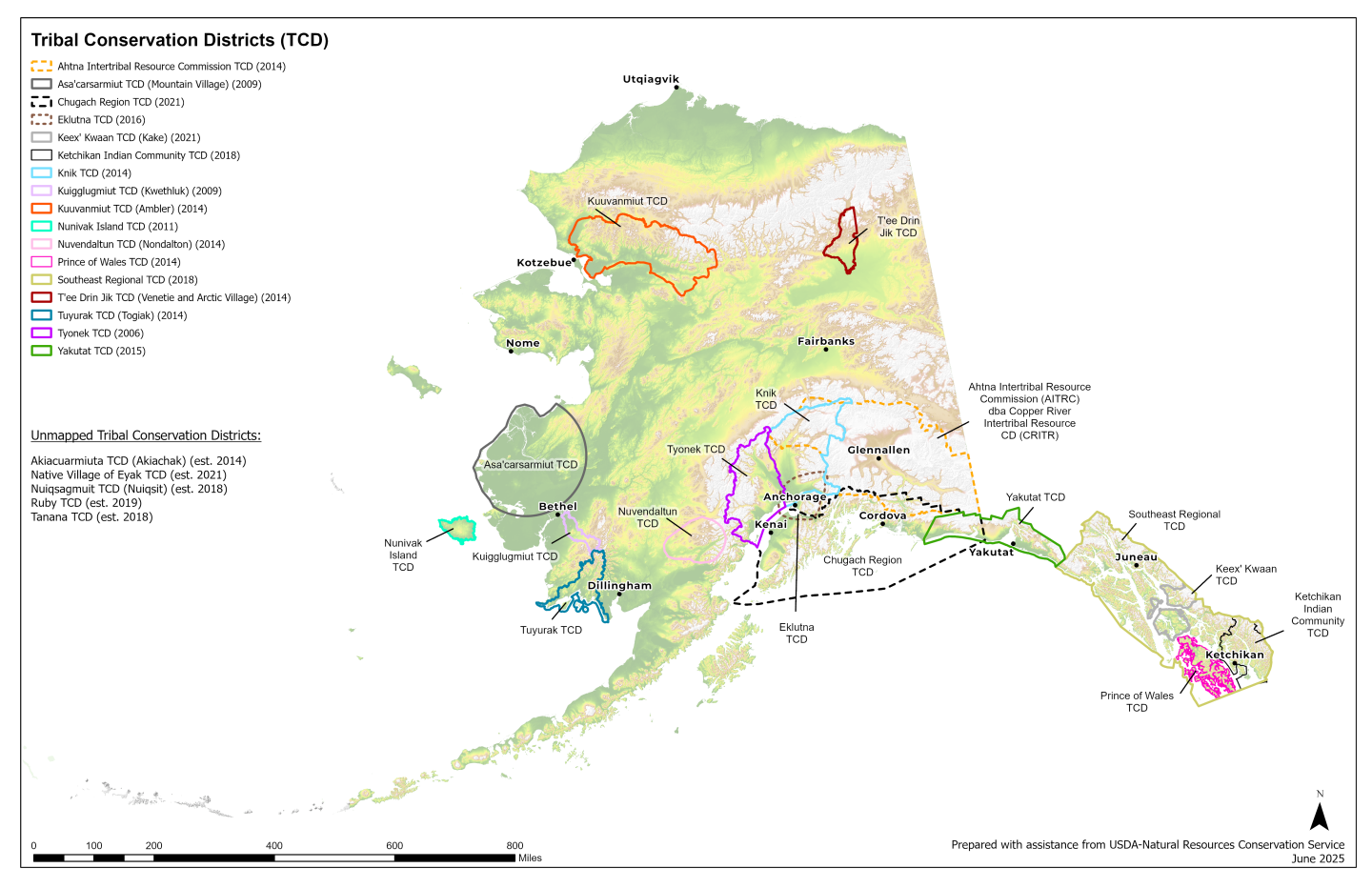
Tribal Conservation Districts (TCDs) combine local and traditional knowledge with technical resources to actively manage natural resources in a defined area.
TCDs establish a formal partnership between the USDA and the tribal nation, allowing for an efficient framework to identify, develop, and provide technical, financial, and educational resources.
What is a TCD?
Tribal Conservation Districts (TCDs) combine local and traditional knowledge with technical resources to actively manage natural resources in a defined area. The goal of a TCD is to set local priorities for conservation and ensure sustainable use of natural resources for subsistence, economic opportunity, resource development, and cultural preservation. TCDs establish a formal partnership between the USDA and the tribal nation, allowing for an efficient framework to identify, develop, and provide technical, financial, and educational resources.
Benefits of a TCD
- Providing a Voice: TCDs provide a local voice in efforts to address natural resource concerns. They provide leadership for intra-tribal coordination between tribal governments and other tribal natural resource managers, and they coordinate assistance from NRCS and other federal, state, local, and private sources.
- Nation-to-Nation Relationship: TCDs work with the USDA in strengthening the government-to-government relationship. A TCD can support enhanced working relationships with state and federal agencies that can assist in meeting the community’s needs.
- Access to Funding: TCDs can provide streamlined access to federal conservation programs within their communities. TCDs can facilitate the application process for tribal landowners to apply for NRCS Farm Bill programs. TCDs may be recipients of funding such as cooperative agreements or partnership agreements. TCDs may apply for a variety of non-federal funding sources to provide match-funding that may be required for federal programs. They provide a mechanism to secure and manage diverse funding sources to accomplish projects on the ground.
- Technical Support: TCDs provide technical, financial, and educational assistance in addressing the resource needs of traditional lands.
Forming a TCD
The TCD formation process is relatively simple but can be lengthy. Typically, one or multiple tribes work with NRCS staff to develop a mutual agreement between the future TCD participants and the USDA. TCD participants may include tribes and village and/ or regional tribal non-profits and corporations. Additionally, each participating tribal entity must draft and sign a resolution through their governing body which authorizes the future TCD to be a party in the agreement. NRCS then submits these documents through a series of approvals all the way up to the U.S. Secretary of Agriculture.
Step-by-Step Process to Form a TCD
- Tribal entity determines interest in creating a TCD. In Alaska, TCDs are typically initiated by one or more local tribes, though participating entities may include village and/or regional non-profits and corporations.
- NRCS provides TCD participants templates for one Mutual Agreement (MA) and a resolution for each TCD participant. All entities are signatories of the MA.
- NRCS will review the MA and all corresponding resolutions and draft a Cover Memo. These three items comprise the TCD package.
- The TCD package is sent to the NRCS State Conservationist for review. It is then elevated through a series of governmental offices for review and approval. At any point in the review process the package can be returned to NRCS Alaska for clarification, inconsistencies, incomplete information, or other concerns.
- If the package successfully completes the multi-step review process, the USDA Office of Executive Secretariat submits it to the Office of the Secretary (OSEC) to secure the Secretary’s
signature. - The package is then first signed by the Secretary of Agriculture, then by leadership of each participating tribal entity.
- USDA encourages TCD participants to have a signing ceremony, develop a TCD board
and bylaws, and identify and define common goals, roles and expectations.

Alaska Tribal Conservation Districts by Year Established
- Bering Sea Interior TCD - Pending
- Native Village of Goodnews Bay Tribal Designated Conservation District - Pending
- Chugach Region TCD - 2021
- Keex’ Kwaan TCD (Kake) - 2021
- Ruby TCD - 2019
- Ketchikan Indian Community TCD - 2018
- Nuiqsagmiut TCD (Nuiqsut) - 2018
- Southeast Regional TCD - 2018
- Tanana TCD - 2018
- Eklutna TCD - 2016
- Yakutat TCD - 2015
- Ahtna Intertribal Resource Commission TCD - 2014
- Akiacuarmiut TCD - 2014
- Knik TCD - 2014
- Kuuvanmiut TCD (Ambler) - 2014
- Nuvendaltun TCD (Nondalton) - 2014
- Prince of Wales TCD - 2014
- T’ee Drink Jik TCD (Venetie) - 2014
- Tuyurak TCD (Togiak) - 2014
- Nunivak Island TCD (Mekoryuk) - 2011
- Asa’carsarmiut TCD (Mountain Village) - 2009
- Kuigglugmiut TCD (Kwethluk) - 2009
- Tyonek TCD - 2006

